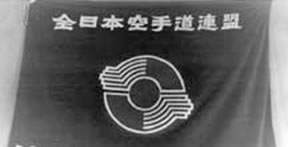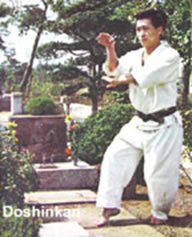Sensei Toyama in Japan
In 1930 Kanken Toyama left Taiwan, returned to Okinawa briefly, and then moved to mainland Japan and on March 20th, 1930 established his home and dojo in the Shimo Meguro district of Tokyo.
Toyama’s home was in an “L” shape. The short part of the “L” was his family’s two story residence. The long part of the “L” was the single story dojo with a high ceiling.
Sensei Toyama named the dojo portion of his home the Shudokan. This was never the name of his system or style of Karatedo as some later thought. It was only the name of the training hall. “Shu” means “to study”. “Do” means “the Way”, in this case, Karatedo. “Kan” simply means hall or building. In 1933 Toyama formed an organization called “Zen Nippon Karatedo Renmei” (All Japan Karatedo Federation). Therefore, his dojo was also known throughout Japan as “Zen Nippon Karatedo Renmei Sohombu” (All Japan Karatedo Federation General Headquarters).

Flag of Toyama Sensei’s
Zen Nippon Karatedo Renmei
(All Japan Karatedo Federation)
During the 1920s and 1930s many Okinawan Karatedo practitioners moved to mainland Japan to teach. Each of these Karatedo teachers formed their own systems with new names, such as Goju-ryu, Shito-ryu, Shotokan, etc., to differentiate their Karatedo from other groups.
When Sensei Toyama began teaching in Japan, it was expected that he would also give a name to his “style” of Karatedo. However, having extensively studied all of Okinawa’s traditional Karatedo, Toyama was dedicated to preserving all of it, not just this or that portion of it. Consequently, he chose not to give a “system name” to his form of Karatedo. He therefore called it “Okinawa Seito Karatedo”, which means “Classical Okinawan Karatedo”. The name strongly implies Okinawan Karatedo in its entirety, rather than a particular segment of it.
In 1895 the Dai Nippon Butokukai (Greater Japan Martial Virtue Society) was established by the Japanese government (Japanese Ministry of Education) to regulate all forms of Japanese Budo. The Butokukai recognized Sensei Toyama’s unique training and mastership of all forms of Okinawan Karatedo, and in 1937 gave him an exclusive license to promote to any rank (Dan) or teacher’s title (Shogo), regardless of the type of Karatedo the promoted individual practiced. He was the only Karatedo teacher in Japan or Okinawa to ever be given this kind of license.
Some of the foremost Okinawan and Japanese Karatedo masters, who formed their own styles, received their 8th 9th or 10th Dan degrees or their teacher’s titles of Shihan or Hanshi from Kanken Toyama. For example, Sensei Eizo Shimabukuro, one of the most respected teachers of Shorin-ryu Karatedo in Okinawa, received his Judan (10th degree) from Toyama, as did Sensei Kanki Izumigawa, the founder of one of the largest systems of Goju-ryu Karatedo in Japan.
Kanken Toyama passed away on November 24th 1966 at the age of 79. He actively taught until the last year of his life. His home continued to be occupied by his family, who allowed the dojo to be used by his students, but as per Toyama Sensei’s wishes, the name Shudokan was discontinued, and the dojo name was thereafter changed to the Kanken Toyama Memorial Dojo.
Note:
Those outside of Japan who continue to use the name Shudokan do so out of their devotion to Sensei Toyama. They understandably have not known of the history and wishes of Toyama in regard to the name Shudokan, because they have not been widely published, and their Karatedo should not be considered somehow less legitimate because of it.
The main curriculum at Toyama’s dojo was Itosu’s Shuri-te type of training, sometimes called Itosu-ha (Itosu lineage) by historians. Most students did not learn the Naha-te, Tomari-de or Shina Kempo (Chinese Chuan-fa) unless that was their original training, and they came to Toyama to further their training in that form.
Between 1930 and 1966, Sensei Toyama raised nearly 100 students to the Shihan level, and a few to the Hanshi level. Most were taught the Itosu-ha. However, there was one student that Toyama Sensei considered his successor, to whom he taught all of Okinawa’s Traditional Karatedo, and that was Isao Ichikawa.

Hanshi 10 Dan
Isao Ichikawa
Young Ichikawa started training with Sensei Toyama when he was six years old. In addition to attending group practices, he regularly visited Toyama Sensei’s home for private training in the traditional way.
Before he died, Sensei Toyama conferred Ichikawa with Judan (10th degree) and the shogo (teacher’s title) of Hanshi. Soon after Sensei Toyama’s death, Hanshi Ichikawa moved to Vienna, Austria and founded Karatedo Doshinkan.

Ichikawa Hanshi at
Kanken Toyama’s grave
